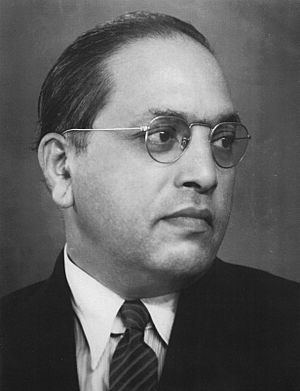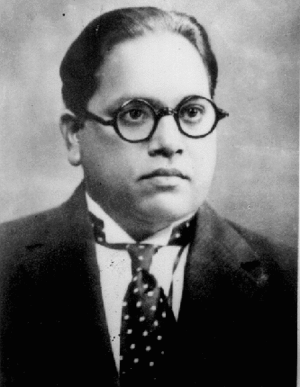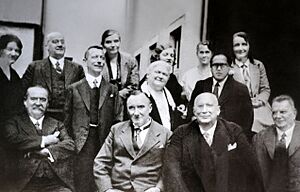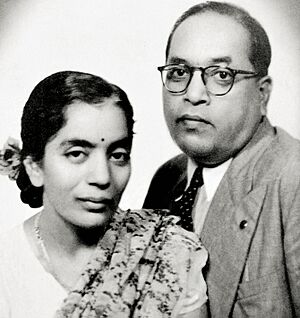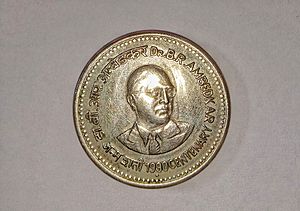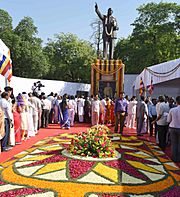Babasaheb Ambedkar facts for kids
Bhimrao Ramji Ambedkar (born April 14, 1891 – died December 6, 1956) was a very important person in Indian history. He was a lawyer, an expert in economics, a politician, and a social reformer. This means he worked to make society fairer for everyone.
He is often called Babasaheb Ambedkar. His followers gave him this name because they saw him as a father figure who guided them. He fought against unfair treatment of people called Untouchables or Dalits. He also supported the rights of women and workers. After India became independent, he was the first law minister. He was also the main person who wrote the Constitution of India, which is like the rulebook for the country. He helped create the Republic of India.
Contents
Early life
Ambedkar was born on April 14, 1891, in a town called Mhow (now known as Dr. Ambedkar Nagar). This town is in Madhya Pradesh. He was the 14th and last child in his family. His father, Ramji Maloji Sakpal, was an army officer. His mother was Bhimabai Sakpal.
His family came from the Marathi background in Maharashtra. Ambedkar was born into the Mahar caste, which was considered "untouchable." People from this caste faced a lot of unfair treatment and discrimination. His family had a history of working for the British East India Company army. His father also served in the British Indian Army.
Even though Ambedkar and other children from his community went to school, they were kept separate. Teachers often ignored them. They were not allowed to sit inside the classroom. When they needed water, someone from a higher caste had to pour it for them. They were not allowed to touch the water or the pot. This was often done by the school helper. If the helper wasn't there, Ambedkar had to go without water. He later wrote about this, saying, "No peon, No Water." He also had to bring his own mat (a gunny sack) to sit on and take it home every day.
In 1894, his father retired, and the family moved. Soon after, Ambedkar's mother died. His aunt took care of the children, and they lived in tough conditions. Out of all his brothers and sisters, only Ambedkar passed his exams and went to high school. His original family name was Sakpal. But his father registered him as Ambadawekar at school. This meant he was from his village, 'Ambadawe'. Later, his teacher, Krishnaji Keshav Ambedkar, changed his last name to 'Ambedkar' in the school records.
Education
Starting College
In 1897, Ambedkar's family moved to Mumbai. There, he became the only "untouchable" student at Elphinstone High School. In 1906, when he was about 15, he married Ramabai, who was nine years old. This marriage was arranged by their parents, as was common at that time.
Studying at Bombay University
In 1907, he passed his high school exams. The next year, he joined Elphinstone College, which was part of the University of Bombay. He said he was the first person from his Mahar caste to do so. When he passed his English exams, his community celebrated. They felt he had reached "great heights." At this celebration, a family friend gave him a book about the Buddha.
By 1912, he earned his degree in economics and political science from Bombay University. He was ready to start working for the Baroda government. His wife and young family had just moved when he had to rush back to Mumbai. His father was very sick and died on February 2, 1913.
Studying in America
In 1913, when Ambedkar was 22, he received a scholarship. It was from the Baroda State, given by Sayajirao Gaekwad III. This scholarship helped him study at Columbia University in New York City. He lived with a friend named Naval Bhathena. In June 1915, he earned his first master's degree (M.A.) in economics. He also studied sociology, history, philosophy, and anthropology. His thesis was about Ancient Indian Commerce. He was inspired by the ideas of John Dewey about democracy.
In 1916, he finished his second master's thesis. It was called National Dividend of India – A Historic and Analytical Study. On May 9, he gave a presentation called Castes in India: Their Mechanism, Genesis and Development. He received his Ph.D. degree in economics from Columbia in 1927.
Studying in London
In October 1916, he started studying to become a lawyer at Gray's Inn. At the same time, he also enrolled at the London School of Economics to work on another doctoral degree. In June 1917, he had to return to India because his scholarship ended. His collection of books was sent on a different ship. Sadly, that ship was sunk by a German submarine. He later got permission to return to London to finish his studies. He went back as soon as he could and earned another master's degree in 1921. His thesis was about "The problem of the rupee: Its origin and its solution." In 1923, he earned a D.Sc. (Doctor of Science) in Economics from the University of London. In the same year, he officially became a barrister (a type of lawyer) at Gray's Inn.
Marriages
Ambedkar's first wife, Ramabai, passed away in 1935 after a long illness. In the late 1940s, after finishing the first draft of India's constitution, he was not feeling well. He had trouble sleeping and pain in his legs. He went to Mumbai for treatment. There, he met Dr. Sharada Kabir. He married her on April 15, 1948, at his home in New Delhi. Doctors had suggested he needed a companion who could cook well and had medical knowledge to care for him. She took the name Savita Ambedkar and cared for him for the rest of his life. Savita Ambedkar, also called 'Mai', died on May 29, 2003, in Mumbai.
Legacy
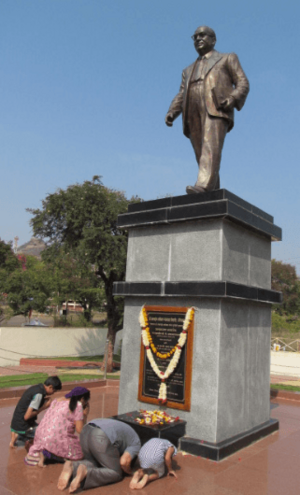
Ambedkar's work as a social and political reformer had a huge impact on modern India. Even today, his ideas are respected by many different political groups. His efforts have changed how India thinks about social policies, education, and helping disadvantaged groups. Because he was such a great scholar, he was chosen as India's first law minister. He also led the committee that wrote the Indian constitution.
He strongly believed in individual freedom and spoke out against the caste system. He said that Hinduism was the basis of the caste system, which made some Hindus disagree with him. His decision to convert to Buddhism made many people in India and other countries interested in Buddhist ideas again.
Many public places are named after him. These include the Dr. Babasaheb Ambedkar International Airport in Nagpur and Ambedkar University Delhi. The government of Maharashtra bought a house in London where Ambedkar lived as a student. This house is planned to become a museum to honor him.
In 2012, a poll by History TV18 and CNN IBN voted Ambedkar "the Greatest Indian." He received nearly 20 million votes. Many famous economists have praised his contributions to economics. Amartya Sen, a Nobel Prize winner, called Ambedkar "father of my economics."
On April 2, 1967, a 3.66-meter (12-foot) tall bronze statue of Ambedkar was placed in the Parliament of India. The President of India, Sarvepalli Radhakrishnan, unveiled it. On April 12, 1990, a portrait of Dr. B.R. Ambedkar was placed in the Central Hall of Parliament House. The Prime Minister of India, V. P. Singh, unveiled this portrait. Another portrait of Ambedkar is in the Parliamentary Museum.
Indian Post has issued many stamps honoring his birthday. These were released in 1966, 1973, 1991, 2001, and 2013. He was also featured on other stamps in 2009, 2015, 2016, 2017, and 2020.
Ambedkar's ideas have led to many political parties, newspapers, and workers' unions. These groups are still active across India, especially in Maharashtra. His support for Buddhism has brought new interest in Buddhist ideas among many people in India. Today, human rights activists organize large conversion ceremonies. They follow Ambedkar's example from 1956. Some Indian Buddhists see him as a Bodhisattva, a wise being. Outside India, some Romani people in Hungary have found similarities between their struggles and those of disadvantaged people in India. Inspired by Ambedkar, they have started to convert to Buddhism.
Images for kids
See also
 In Spanish: B.R. Ambedkar para niños
In Spanish: B.R. Ambedkar para niños


